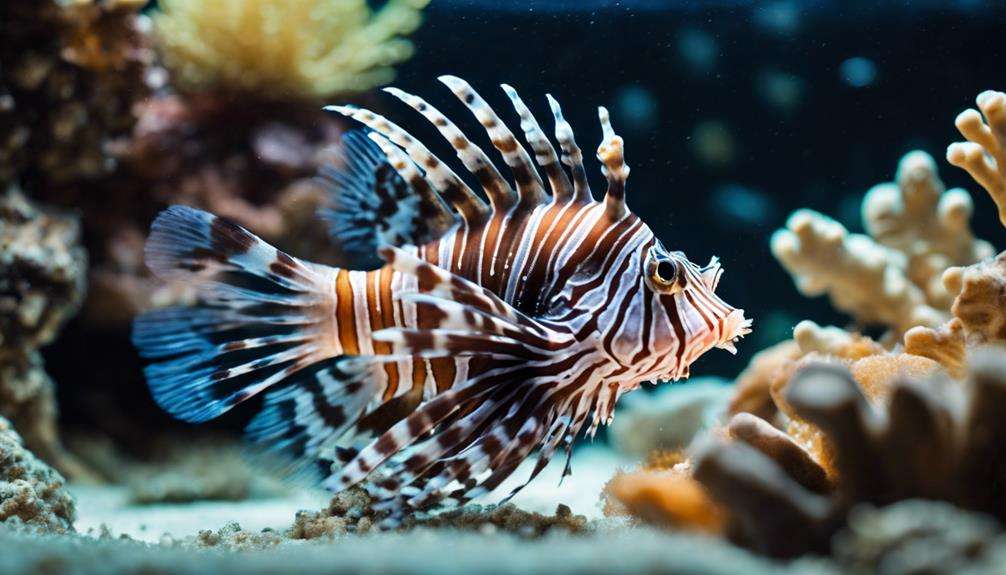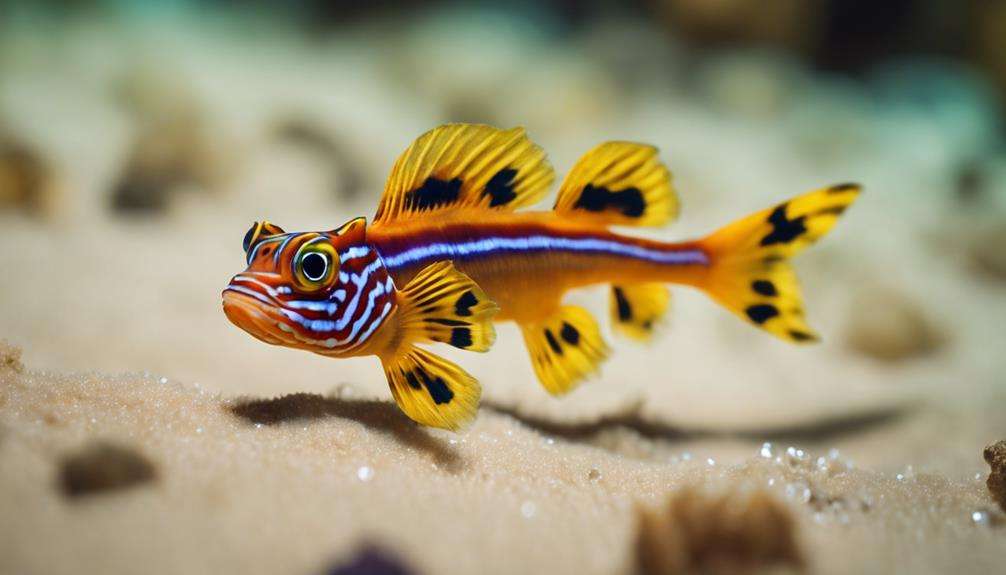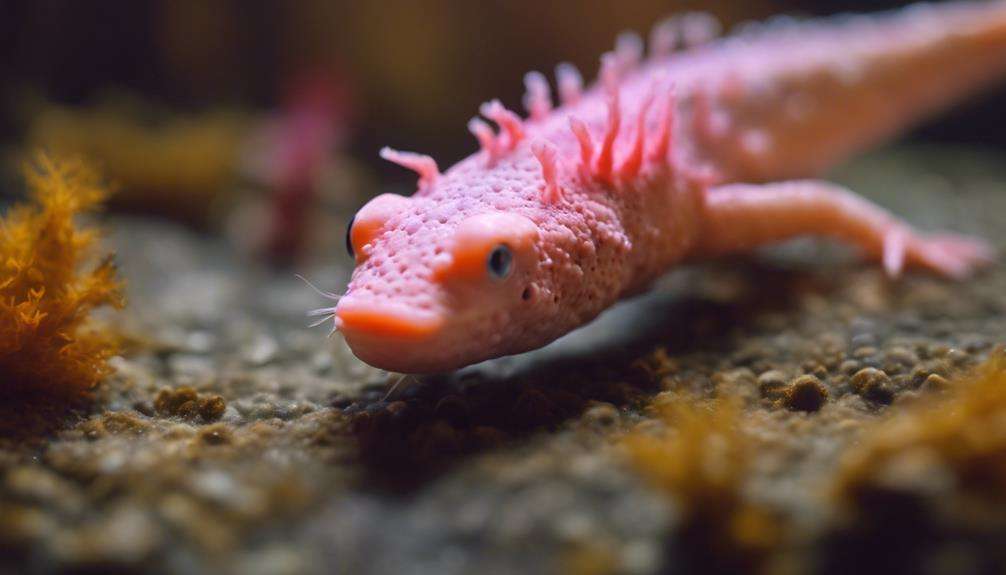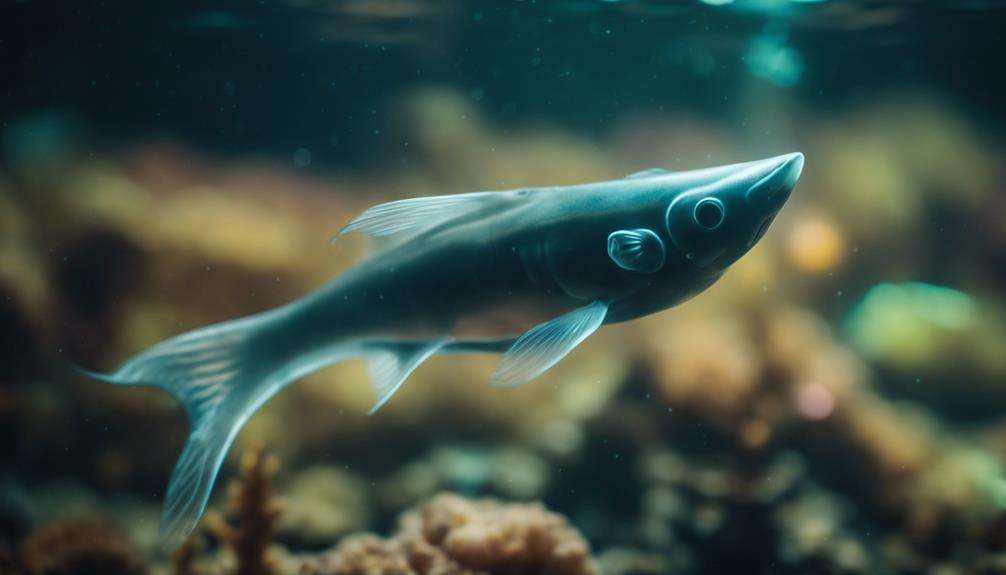Have you ever pondered the intriguing theory that the Stargazer fish might possess hidden communication methods far beyond our current understanding?
As you explore the depths of their habitat, you may stumble upon behaviors that hint at a complex social structure and interaction among these enigmatic creatures.
The realm of Stargazer behavior holds a multitude of secrets waiting to be unraveled, shedding light on their mysterious ways.
Key Takeaways
- Stargazers employ unique predatory techniques like electrogenic abilities and venomous spines for hunting.
- Their strategic hunting behaviors include ambush predation, electric lure hunting, and specialized feeding techniques.
- Stargazers showcase defensive mechanisms with electric organs and venomous spines, enhancing survival in ocean depths.
- Limited social behaviors in stargazers emphasize solitary nature with social interactions primarily during courtship and reproduction.
Electrogenic Abilities of Stargazer Fish
Stargazer fish, particularly those belonging to the Uranoscopidae family, exhibit remarkable electrogenic abilities enabling them to generate electric shocks for hunting and self-defense purposes. These electric shocks serve a dual purpose in their predatory tactics: aiding in ambush hunting and deterring potential threats. When hunting, stargazers bury themselves in the sand, leaving only their eyes exposed, waiting for unsuspecting prey to swim by. Once a suitable target is within striking distance, they deliver a quick electric shock, stunning the prey and making it easier to capture.
The ambush strategy of stargazers is highly effective due to their unique bioelectrogenic capabilities. By generating electric shocks, they're able to incapacitate prey swiftly without the need for a physical chase. This energy-efficient hunting method allows stargazers to conserve energy while securing their next meal. Additionally, the electric shocks produced by these fish can also be used defensively, deterring predators that may try to attack them. The electric organs of stargazers, derived from modified eye muscles or sonic muscles, play a crucial role in these fascinating behaviors.
Venomous Tactics in Stargazer Behavior
Stargazers utilize their venomous spines as a formidable defense mechanism, capable of inflicting painful stings and deterring potential threats.
Their ambush predator strategy involves blending into their surroundings, waiting for prey to come within striking distance before delivering a potent venomous attack.
Additionally, the element of surprise is enhanced by their ability to deliver electric shocks, further incapacitating their unsuspecting victims.
Stinging Spine Defense
With their strategically placed venomous spines, stargazers employ a potent defense mechanism to ward off potential threats in their natural habitat. These venomous tactics are essential for their survival, and here's why:
- Stargazers possess venomous spines as a defense mechanism against predators.
- The venom of stargazers can cause pain, swelling, and potential complications in humans.
- Stargazers use their venomous spines for protection and to deter threats.
- The venom of stargazers is injected through their spines upon contact.
Stargazers rely on their venomous spines as a primary line of defense in their predatory environment, showcasing the fascinating adaptations these fish have developed for self-preservation.
Ambush Predator Strategy
Incorporating venomous spines and electric shocks into their hunting strategy, stargazers exhibit a sophisticated ambush predator behavior to efficiently capture prey and defend against threats in their marine habitats.
As ambush predators, stargazers leverage their electric organs to deliver stunning shocks that immobilize unsuspecting prey or deter potential predators. This combination of venomous spines and electric capabilities allows stargazers to incapacitate prey swiftly, ensuring a successful hunt.
By relying on their bioelectrogenic abilities, stargazers can precisely target their victims from concealed positions in the sandy seabed, showcasing their adaptation for efficient hunting.
The utilization of venomous tactics and electric shocks underscores the formidable predatory nature of stargazers in their ecosystems, highlighting their unique and effective hunting strategies.
Electric Shock Surprise
Utilizing their bioelectrogenic capabilities, stargazer fish deploy a dual-threat strategy involving both venomous spines and electric shocks to effectively immobilize prey and deter potential threats in their marine habitats. This unique combination of venomous spines and electric shocks allows stargazers to be formidable predators in the underwater world.
Here are some fascinating facts about their electric shock surprise:
- Stargazer fish can generate electric shocks up to 50 volts to stun prey and deter predators.
- Some stargazers possess venomous spines that inject potent venom into their victims.
- Their electric organs are used for offensive and defensive tactics during hunting and self-defense.
- Stargazers have evolved unique bioelectrogenesis capabilities for stunning prey efficiently.
Stargazer Fish: Masters of Ambush
Stargazer fish, masters of ambush, exhibit a unique hunting strategy that involves burying themselves in sand and patiently waiting for unsuspecting prey to pass by. Their specialized eyes, positioned on top of their heads, grant them a strategic advantage in detecting potential meals while effectively hidden. Employing a sit-and-wait approach, stargazers capitalize on their sharp teeth and swift strikes to capture small fish and crustaceans that come within striking distance.
These cunning predators also leverage their bioelectronic capabilities, including electric shocks and venomous spines, not only to immobilize prey but also to defend themselves against potential threats from other marine creatures. Their offensive and defensive tactics make stargazers formidable ambush predators in the ocean, showcasing a remarkable balance of aggression and defense in their hunting techniques.
Solitary Reproduction Strategies of Stargazers
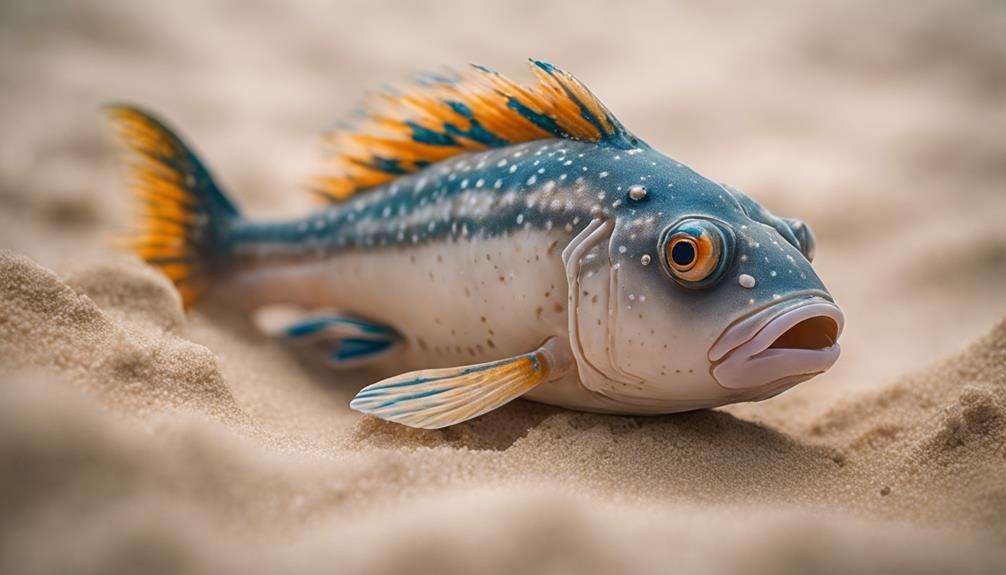
During their specific breeding seasons, stargazers demonstrate solitary reproduction behavior, engaging in external fertilization in shallow waters where eggs and sperm are released for fertilization. This process involves the female stargazer laying eggs on the ocean bottom, where they're then fertilized by the released sperm. Here are some key points to understand the solitary reproduction strategies of stargazers:
- Stargazers exhibit solitary reproduction behavior, spawning individually during particular breeding seasons.
- External fertilization is the primary method of reproduction for stargazers, with eggs and sperm being released into the water for fertilization.
- Females deposit their eggs on the ocean floor, where they develop and eventually hatch into larvae.
- Stargazers achieve sexual maturity between 4 to 8 months after hatching, allowing them to participate in the reproductive cycle efficiently.
The solitary nature of stargazers extends to their reproductive habits, where they don't engage in group spawning activities commonly seen in other fish species.
Unique Burrowing Habits of Stargazer Fish
Burying themselves in sandy or muddy ocean floors, stargazer fish employ a unique camouflage strategy for protection and hunting purposes. This burrowing behavior allows them to remain hidden, with only their eyes and mouths exposed, ready to ambush unsuspecting prey. By blending seamlessly into their surroundings, stargazers can evade predators and surprise passing prey using their sit-and-wait hunting technique effectively.
Stargazers exhibit a preference for sedimentary environments in shallow, temperate waters, where they can bury themselves efficiently to maximize the success of their ambushes. This unique burrowing habit is a crucial adaptation that plays a vital role in their survival and predatory strategies. The ability to disappear beneath the ocean floor not only provides them with protection but also enhances their hunting prowess, making them formidable predators in their ecosystem.
This behavior showcases the remarkable evolutionary adaptations of stargazer fish, highlighting their mastery of stealth and patience in the underwater world.
Social Behavior Insights in Stargazers

After exploring stargazer fish's unique burrowing habits, it's essential to shift focus towards understanding their limited social behavior insights. Stargazers, known for their solitary nature, exhibit minimal social behavior, except during mating season. Here are some key insights into the social behavior of these intriguing fish:
- Stargazers rely on their top-mounted eyes to scan their surroundings for potential prey, enabling them to execute precise ambush tactics.
- They don't engage in complex social structures or group interactions, prioritizing solitary hunting and survival strategies.
- Limited social behaviors are primarily observed during courtship and mating rituals, where brief interactions between individuals occur.
- Social interactions in stargazers are predominantly linked to reproduction, with minimal significance in their daily behavior patterns.
Understanding the social behavior of stargazer fish sheds light on how they navigate their environment using stealth and ambush tactics rather than social cooperation.
Stargazer Fish Feeding Techniques
Stargazer fish exhibit an intricate feeding behavior that combines ambush predation strategies with electric lure hunting techniques. These predatory fish are known for their ability to bury themselves in the sand, waiting patiently for unsuspecting prey to pass by before striking with precision.
Ambush Predation Strategy
Utilizing a sophisticated ambush predation strategy, stargazer fish employ specialized adaptations to surprise and capture their unsuspecting prey. These fascinating creatures have evolved unique techniques for successful hunting:
- Burying Technique: Stargazers bury themselves in sand or mud to blend in with their surroundings.
- Sharp Teeth: They possess sharp teeth to swiftly catch their prey once it's within reach.
- Vacuum-like Mouth: Stargazers use their vacuum-like mouths to create suction for sucking in prey.
- Tentacle-like Appendages: Specialized tentacle-like appendages aid in grabbing and securing their unsuspecting victims.
Stargazers' precise and patient approach to ambush predation showcases their remarkable hunting prowess in the depths of the ocean.
Electric Lure Hunting
Employing a unique and efficient feeding strategy, stargazer fish utilize electric lures to attract and stun unsuspecting prey, enabling them to capture their meals with precision and minimal energy expenditure.
These fish have specialized organs capable of producing electric fields, which they deploy through their electric lure positioned strategically near their mouth. By mimicking the movements of small prey, the electric lure draws in other fish and invertebrates towards the stargazer.
Once the prey is within striking distance, the stargazer can deliver a powerful electric shock, stunning the unsuspecting victim. This combination of luring and shocking allows stargazers to efficiently hunt and consume their prey without the need for excessive physical pursuit, showcasing the remarkable predatory adaptations of these fascinating fish.
Buried Sand Ambush
Taking advantage of their surroundings, stargazer fish strategically bury themselves in the sand to execute their ambush feeding technique. This behavior showcases their adaptation as ambush predators in the ocean environment. Here are some key points to understand their buried sand ambush strategy:
- Stargazers remain hidden in the sand until an opportunity to strike arises.
- Their camouflage pattern and buried position help them efficiently capture passing prey.
- This technique allows stargazers to patiently wait for vulnerable food sources to approach.
- With rapid strike capability and sharp teeth, they lunge out from their sandy hideout to catch unsuspecting prey.
Strategic Life of Stargazer Fish
Stargazer fish strategically bury themselves in sand to ambush prey, utilizing their unique eyes on top of their heads and upward-facing mouth for efficient hunting. This adaptation allows them to blend seamlessly into their sandy surroundings, becoming nearly invisible to passing prey. By remaining motionless and patiently waiting for the right moment, stargazers maximize their chances of a successful ambush. Their camouflage pattern further aids in concealing them until the opportune instant to strike presents itself.
In addition to their physical camouflage, stargazers possess sharp teeth that enable swift and decisive attacks on unsuspecting prey. This predatory advantage, combined with their bioelectronic abilities such as electric shocks and venomous spines, makes them formidable ambush predators. Their strategic approach to hunting, coupled with their aggressive nature, solidifies their reputation as one of the ocean's most skilled and cunning hunters. Stargazer fish have honed their hunting techniques over time, evolving to become masters of stealth and precision in capturing their next meal.
The Art of Stargazer Ambushes

Stargazers exhibit remarkable skills in executing their ambushes with precision and effectiveness. Their choice of secretive burrow locations provides them with the perfect vantage point to monitor their surroundings.
When the moment is right, they unleash lightning-speed attacks on unsuspecting prey, blending their camouflage mastery seamlessly into their ambush strategy.
Secretive Burrow Locations
In their chosen sandy or muddy ocean floor habitats, stargazers meticulously select secretive burrow locations to enhance their ambush capabilities. These burrowing spots play a crucial role in their predatory strategy, allowing them to remain hidden until the perfect moment to strike.
Here are some intriguing aspects of stargazers' secretive burrow locations:
- Camouflaging themselves with the sandy or muddy ocean floor.
- Burying themselves with only their eyes and mouths exposed for observation.
- Utilizing a sit-and-wait approach to predation, maximizing the element of surprise.
- Preferring sedimentary environments in shallow, temperate waters for their unique burrowing technique.
Stargazers' strategic choice of burrow locations not only aids in their protection from predators but also ensures successful ambushes on unsuspecting prey.
Lightning Speed Attacks
Meticulously choosing their hidden sandy or muddy ocean floor locations, stargazers unleash lightning speed attacks on unsuspecting prey, showcasing their specialized ambush techniques. These ambush predators rely on their lightning speed attacks to swiftly capture passing fish or invertebrates.
With sharp teeth and a unique hunting strategy, stargazers surprise and overwhelm their prey with precise movements. Their ambush strategy allows them to efficiently lunge at prey, demonstrating their predatory prowess.
This specialized hunting behavior highlights the stargazers' adaptation for successful ambushes, emphasizing their ability to swiftly strike and secure meals. The lightning speed attacks of stargazers exemplify their predatory efficiency and skill in capturing prey in the blink of an eye.
Camouflage Mastery Skills
Exhibiting unparalleled mastery of camouflage, stargazers adeptly conceal themselves within the sandy or muddy ocean floors, positioning their eyes and mouths strategically for optimal ambush effectiveness. Stargazers have honed their ambush technique to perfection, utilizing their sand-colored bodies to blend seamlessly into the environment. Here are some key points regarding their camouflage mastery skills:
- Stargazers have mastered the art of blending in with their surroundings, making them almost invisible to unsuspecting prey.
- Their sit-and-wait strategy involves patiently hiding until the perfect moment to strike.
- By burying themselves in the ocean floor, they leave only their eyes and mouths exposed for a surprise attack.
- This camouflage not only aids in hunting but also acts as a defense mechanism against predators.
Unveiling Stargazer Behavioral Mysteries
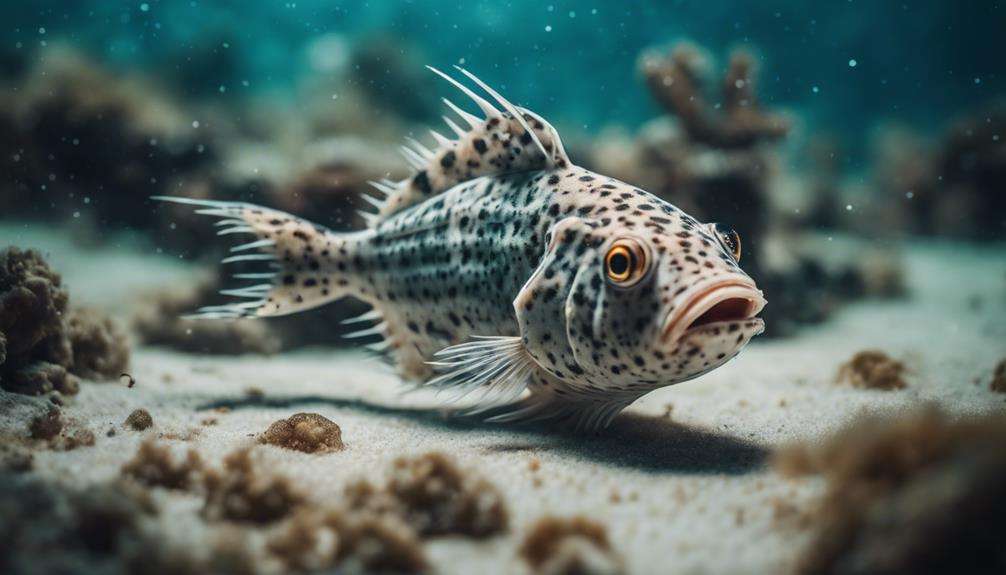
Delving into the depths of stargazer fish behavior reveals intriguing mysteries waiting to be unraveled. Stargazers exhibit a unique predatory technique known as ambush predation, utilizing their specialized electric organs to stun unsuspecting prey.
These electric organs are remarkable adaptations that enable stargazers to incapacitate their victims efficiently. By burying themselves in the sand and lying in wait, stargazers demonstrate exceptional patience as they rely on camouflage and stealth to secure their next meal.
Once a target is within range, stargazers swiftly strike with their sharp teeth, showcasing their aggressive hunting nature. The upward-facing mouth of stargazers aids in capturing prey efficiently from the seafloor, showcasing their evolutionarily optimized hunting strategy.
Unveiling the behavioral mysteries of stargazer fish sheds light on the fascinating interplay between their unique adaptations, predatory habits, and survival instincts in the depths of the ocean.
Frequently Asked Questions
What Are Some Interesting Facts About Stargazer Fish?
You'd find stargazer fish fascinating for their unique adaptations like top-mounted eyes and venomous spines. They employ camouflage techniques, with some using worm-shaped lures. These aggressive hunters also deliver electric shocks, showcasing their offensive and defensive tactics.
How Strong Is a Stargazer Shock?
Stargazers can deliver electric shocks of up to 50 volts for electric defense and predatory behavior. This shock strength is vital for stunning prey and deterring predators. It's a remarkable adaptation that showcases the stargazer's unique abilities.
What Happens if You Step on a Stargazer Fish?
If you step on a stargazer fish, you may experience a painful sting or electric shock due to its venomous spines. This marine life uses its defense strategy of venom and bioelectricity to deter threats, highlighting the dangers of encountering this sea creature.
What Is the Meaning of Stargazer Fish?
When you ask about the meaning of stargazer fish, you uncover a world of underwater camouflage and electric shocks. These creatures embody stealth and surprise, utilizing their unique adaptations to hunt and thrive in their marine environment.
Conclusion
You have now delved deep into the fascinating behavior of stargazer fish, uncovering their electrogenic abilities, venomous tactics, and mastery of ambush.
Did you know that the giant stargazer, the largest among them, can grow up to an impressive 90cm in length?
These formidable predators with their unique adaptations make for a truly intriguing study in the underwater world.
Continue exploring the mysteries of stargazer fish for a deeper understanding of their strategic lives.

